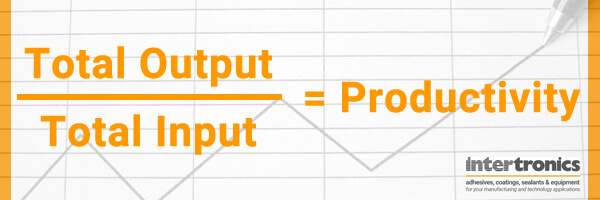Improving Productivity by Increasing Output
When we think about how to increase the productivity of an organisation, we often immediately jump to how to raise output. How can we make more of that widget, or a better version of the widget, within the constraints of our production space or other limited resources? Maybe the market is growing rapidly and we need to scale up production. Or perhaps our local market are buying from abroad because there isn’t enough local supply. Maybe our competitors are leading the charge on defining people’s expectations for that kind of product, and we don’t want to become irrelevant or an also-ran. These are all good reasons to find ways to improve our output while maintaining the same or lower variable cost per widget.
Productivity isn’t analogous with output, though; it’s an equation:

So yes, increasing output without proportionally increasing input does result in greater productivity. An equally valid way to increase productivity is to achieve the same output while decreasing input.
Improving Productivity by Decreasing Input
Perhaps the current market size for your product is limited to what you are already producing at the moment. Could you produce the same amount faster/in fewer shifts, or with less waste/rework, or with fewer processes or people required in the assembly process?
What if you have a process that is done manually by Martha, and she’s a real expert at it, but if she leaves, no one will know how to do what she does? That’s a big risk for future productivity. Or Steve, Diego and Suzanna all perform the same task, but there is variation in how they do that, so each widget produced might differ slightly from the others. That can result in quality issues or customer frustration.
At Intertronics, we talk a lot about accuracy, repeatability, speed and predictability of processes, because this is what often makes the biggest difference in terms of keeping input levels to a minimum whilst producing a consistent, high-quality product.
Where to Start Improving Productivity
Improving productivity doesn’t have to be about making big leaps; it might be about finding ways to increase your production or decrease your inputs by 5% here and there.
We all know that the UK has fallen behind in productivity compared to our G7 cohorts, but it can seem daunting to even consider where to start improving our own processes. If you would like someone to come have a look at what you’re doing and see if they can contribute some ideas for doing that process more efficiently or to a higher standard, let us know. Our particular areas of strength are in processes dealing with adhesives – bonding, sealing, potting, encapsulating, temporary masking; accurate dispensing of liquids; and the operations around these functions – mixing materials, surface preparation, curing, etc.
For some inspiration from our customers who have found many different ways to improve their productivity, read our Case Studies.
Greater output and/or fewer inputs – where can you find potential to improve your productivity?
Posted by Rachel Chancellor
Rachel works in Marketing at Intertronics, managing projects around business development and new products and services.
Who's Rachel?Categories: insights, productivity
